This week’s post was written by Nancy Lingle, a volunteer in the Davidson College Archives & Special Collections. Nancy is a May 2016 graduate of the University of North Carolina at Greensboro with a Masters of Library and Information Studies degree, and works at the Davidson Branch of the Charlotte Mecklenburg Public Library.
Photos from a road trip with college buddies. The scores from an all-important football game. Notes about family and friends. An advertisement for shoes for $16.50. Ticket stubs from a concert. For many of us, these phrases sounds like things we might see on a typical Facebook or Instagram post. But in this case I’m describing a book; to be more specific – a scrapbook from a member of the Davidson College Class of 1929. A scrapbook that does not belong to my family, but now feels like an old family friend.
I came to know this scrapbook through a class assignment. I am not a Davidson College student. (In fact, based on my SAT scores, I’m pretty sure I would never have been admitted.) In pursuit of my MLIS degree at UNCG, I took a class in digital libraries. One option for my final class assignment was to find a local library and ask to work on one of their digital projects. As a resident of Davidson and having been married to someone with long ties to the college, I was familiar with the archival work that the Davidson College Library had produced. With fingers crossed, I emailed Jan Blodgett, the college archivist, and offered my services. Jan, along with Sharon Byrd and Caitlin Christian-Lamb graciously tossed around some possible project ideas that I could work on. They came up with digitizing a scrapbook, one of the 279 that have been collected by or donated to Davidson over the years. These scrapbooks are stored in the college archives – a veritable treasure trove of documents, photographs and other ephemera related to town and gown.
At first, I was slightly surprised by their choice of this project. With all the “important” books, manuscripts and photos that need to be digitized, I thought digitizing a personal scrapbook was something that should possibly be further down on the priority list. How wrong I was.
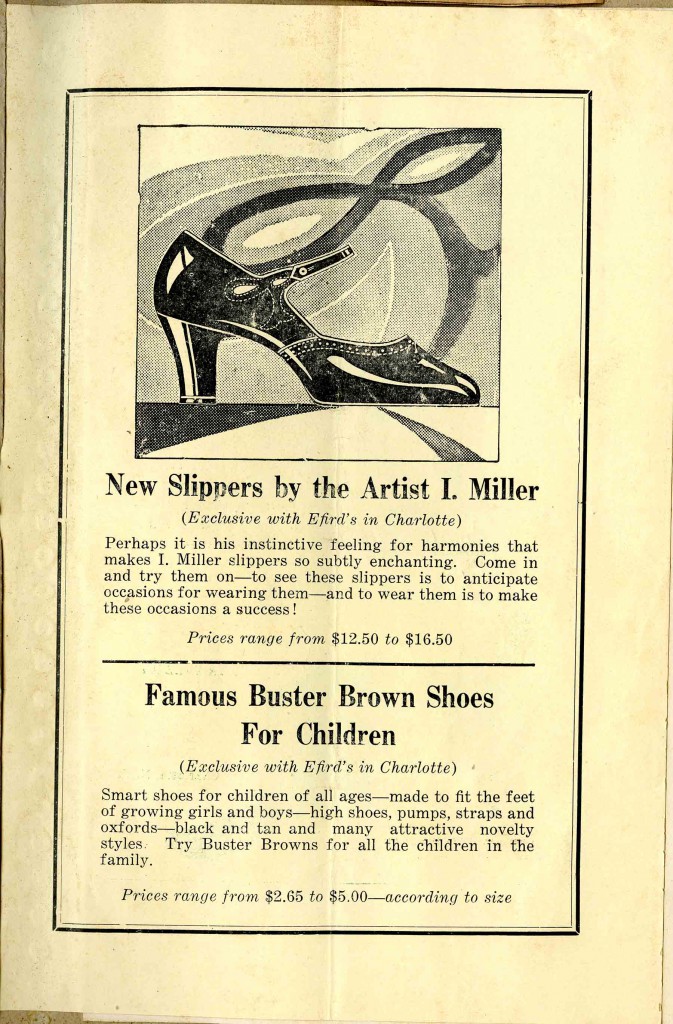
Advertisement for women’s shoes for $12.50 to $16.50 , from a program for “The Girl Friend” at the Auditorium Theatre pasted onto page 79 of Aubrey Neblett Brown, Jr.’s scrapbook.
Why scrapbooks? The reasons are many. Scrapbooks give us a more personal account of a period in history. We can see what was important to an individual at a given time. Newspaper articles, dance cards, photos showing clothing, hats and shoes all come together to paint a detailed picture and give us a higher degree of insight than a standard text book can offer. Digitizing a scrapbook, while adding descriptive and searchable metadata, adds to our collective resources and knowledge sharing abilities. By making these resources available to the public, we can give others the opportunity to access material that would otherwise be nearly impossible to see. Many college and university libraries have been working on digitizing their scrapbook collections. These scrapbooks are in very fragile states; their aging pages crumbling, disintegrating a little more every time we open each archival box. Preserving them for future generations is a worthy task.
The Process
Caitlin was very familiar with the Davidson scrapbook collection. She herself had worked on a similar project when she was a graduate student at Simmons College so she understood with great clarity the details involved. Of all the choices under consideration, we decided to digitize the scrapbook of Aubrey Neblett Brown, Jr. It had lots of nice details, many different types of items and at 82 pages, it seemed the perfect length. The goal was to preserve the scrapbook in a way that makes you feel like you are turning the pages of the actual item – viewing the scrapbook as it was intended to be seen.
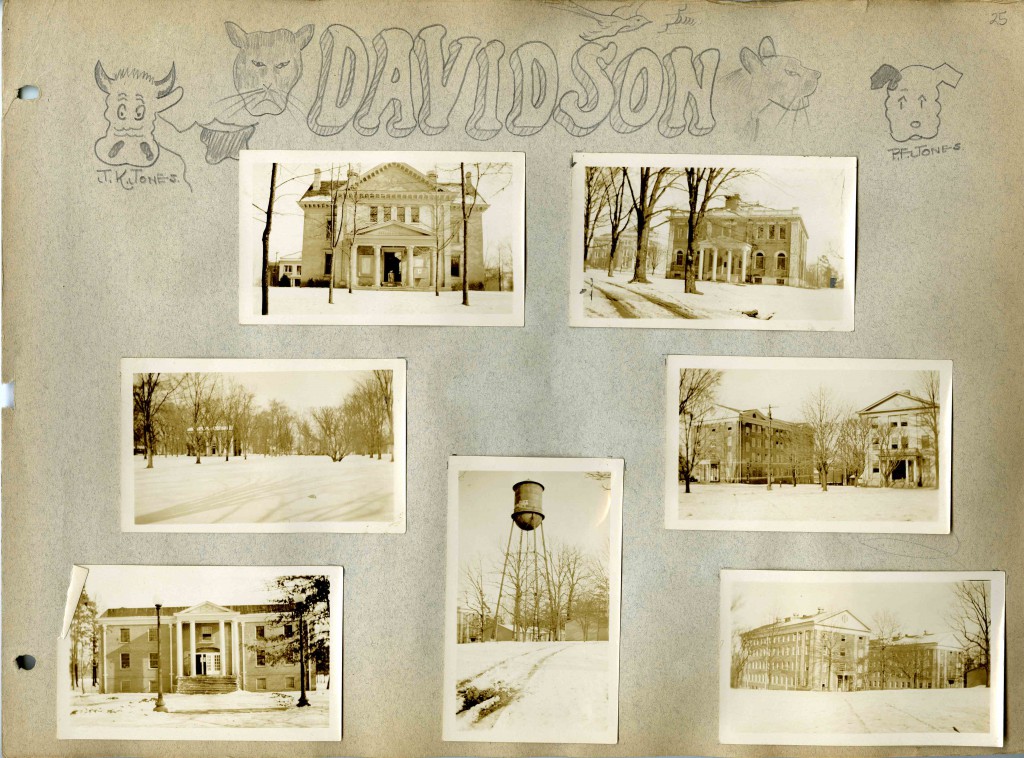
Page 25 of the Brown scrapbook, with photographs of many Davidson College campus buildings and hand-drawn animals (including two wildcats).
First came scanning. Each page of the scrapbook (and each page of each pamphlet or brochure within each page) was scanned and saved as a TIFF file. The pages had to placed carefully on the scanner in an effort to keep them as intact as possible. Sometimes we found pages stuck together either due to the adhesive (mucilage) or a staple. Caitlin, using a scalpel with surgeon-like precision, removed the staples so we could easily access the individual pages. Sometimes items fell off. Often I had to lift one delicate yellowed newspaper clipping to access another one beneath it. One time, a headline that had lain folded for umpteen years crumbled in my hand. While I felt terrible, it also made me realize how important it is to scan these documents so they can be preserved before more disintegration takes place. It turns out this 82-page scrapbook was really 311 pages when all was said and done. Scanning took 24.75 hours.
TIFF files are wonderful at preserving details but are also very large. The Omeka site we were using to host this project has a limitation in file size, so I converted each TIFF to a JPEG. This is a fairly easy process and took only 5.5 hours.
Next, using Dublin Core, I added metadata to each page so the information could be found. Some pages were relatively easy since they contained only one or two items. When questions arose, Sharon patiently looked over my shoulder and help guide me to the correct description. The pages that were most challenging were ones that held copies of plays and programs containing the names of the actors, dancers and musicians. Since our goal was to make the items searchable, I had to add each name that I found on each page. Mr. Brown loved to attend plays. On page 79 there are 5 different play programs. Since I was working on this project only 5-6 hours per week, it would occasionally take me that amount of time to add the metadata for just one page. Total time for adding metadata: 32 hours.
Finally, as I was wrapping up my semester, the metadata was complete. With Caitlin’s expertise and guidance, we turned the project live (8.25 hours) just days before my semester ended. Total time to digitize the Aubrey Neblett Brown Jr. scrapbook: 70.5 hours.
What Did I Learn?
Academically, I learned about the digitization processes, about different hosting sites, about the ways different institutions use Dublin Core as a metadata scheme, all the variables involved and the decisions that need to be made when creating a digital library project.
I also learned about life in Davidson from 1924 – 1929. I learned that Mr. Brown kept a tidy room – there’s a note from Mrs. Black the dormitory supervisor telling him so. (Personally, as the mother of a college-age son, I find this extremely hard to believe.) Photos told me who Mr. Brown’s friends were and what they did for fun; from building a snowman to attending plays and debates as well as coming up with the attributes for the “ideal woman”. I learned that Efird’s Department Store in Charlotte sold almost everything and that even though the Ziegfeld Follies were famous, the creators of the brochures still spelled that eponymous name incorrectly (as “Ziegfield”). Among the various letters and cards there was a note about Mr. Brown’s disappointment over the new college president, Dr. Walter Lee Lingle, my husband’s grandfather, and how he wished it could have been someone from outside and not a Davidson graduate who was taking on the position. (No hard feelings – I promise.)
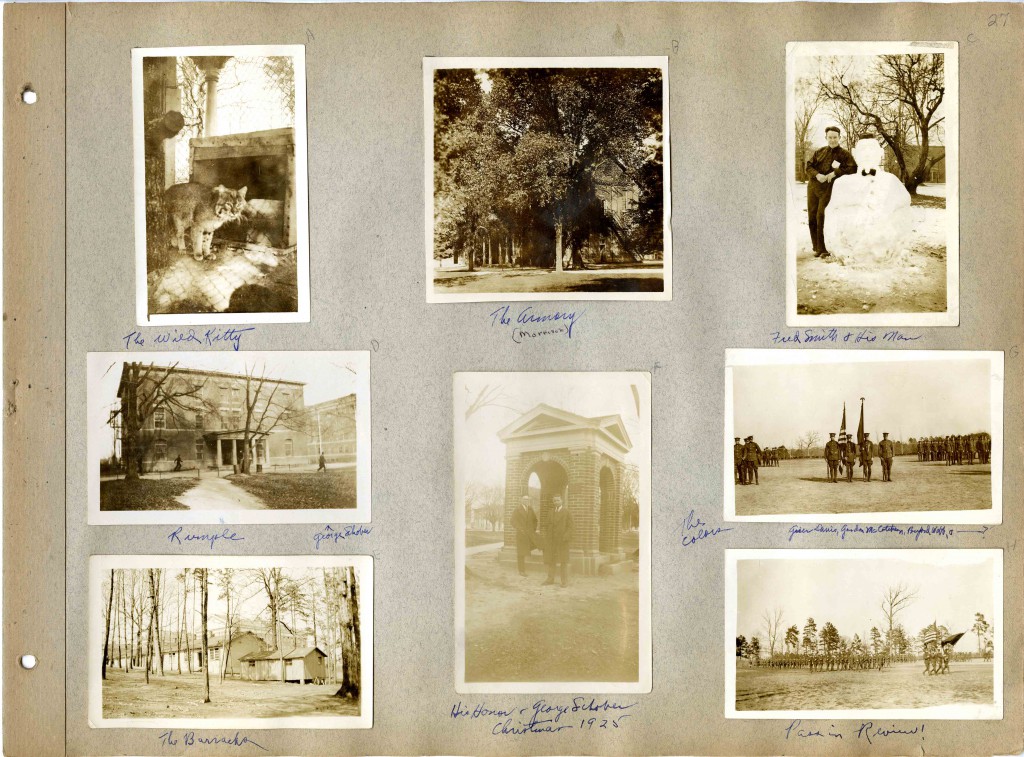
Page 27 from the Brown scrapbook, showing scenes around campus (including snowman-building and one of the live wildcat mascots).
Mr. Brown’s documentation of the road trip he took with friends back home to Mineral Wells, Texas was one of the highlights of the scrapbook. There are photos of the car (which he later sold for $60.00), a map of their route, and postcards he acquired at places he stopped along the way. It was amazing to me that these postcards, many in color, have retained their vibrancy even after all these years.
What I felt the most as I delved into this scrapbook was the sense of innocence, the love of family and friends, the love of sports, the overall “collegiate spirit” vibe that I felt during my own undergraduate days and see now with my son and his friends. This “innocence of youth” of Mr. Brown and his friends is juxtaposed with an impeding sense of sadness since we know what is about to happen in the world later on in his 1929 graduation year.
A few weeks ago I ran into William Brown at the Davidson Public Library where I currently work. William is the son of our scrapbook creator and the Director of the Knobloch Campus Center and Student Activities at Davidson. I told him about the project and thanked him for sharing such a wonderful resource with the college archives and now, thanks to digitization, with anyone who is interested. He smiled and he talked about that road trip his father took to Mineral Wells. It turns out that his father didn’t return home again for over 50 years. When he did, things had changed so much that nothing seemed familiar. Having access to those photos and postcards now seems even more poignant.
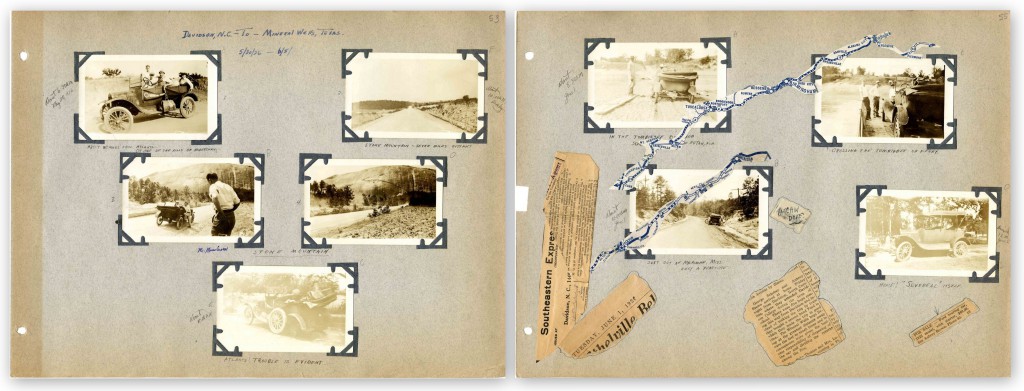
Pages 53 and 55 of the scrapbook, detailing the road trip from Davidson to Mineral Wells, TX and including a newspaper clip advertising Brown’s sale of the group’s 1922 Ford Model T.
The Future
Now with one scrapbook project under their belts, I hope that the Archives and Special Collections Department can continue this project with the help of students and volunteers. Knowing the time and resources it takes to digitize one scrapbook; from computers and scanners to hosting space and librarian oversight, the archivists can better plan how this project fits in with their other projects and goals.
Many thanks to Jan, Sharon, and Caitlin for their guidance, support and allowing me to work with them on bringing this scrapbook to digital life. You can access the digital version of the Aubrey Neblett Brown, Jr. scrapbook here.

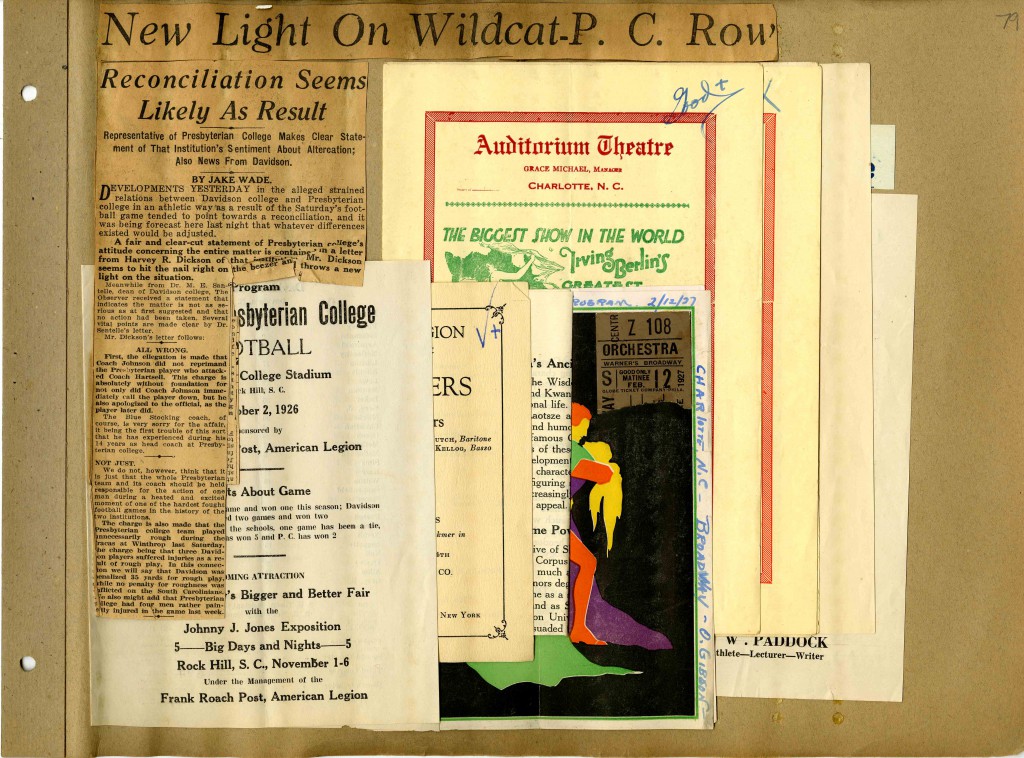

Speak Your Mind